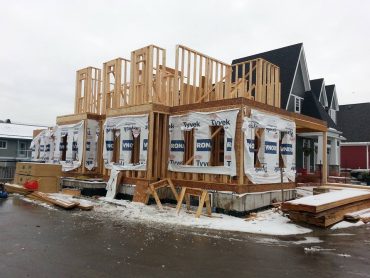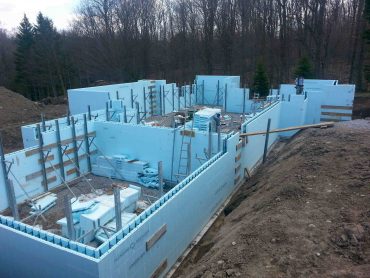
John Bleasby
Understanding continuous air barrier systems
Canadian ContractorAn air barrier is only as good as its installation. Here's why.
As codes across the country begin to mandate higher levels of energy efficiency, the direct implication are building envelopes that must become tighter in terms of air changes per hour (ACH). In order to reduce the tightness of the envelope, every building envelope needs an effective air barrier system.
Is a vapor barrier the same as an air barrier?
But what about vapor barriers, you may ask, that plastic sheeting that everyone installs between the drywall and the insulation? Isn’t that doing the same job?
A vapor barrier is not an air barrier
The short answer is, ‘No.’ Air barriers and vapor barriers have two distinct purposes. The purpose of a vapor barrier is to prevent vapor diffusion. The problem is that vapor barriers, as installed by most builders, do not enclose the entire envelope and are often punctured either by accident or while installing other infrastructure in the home. That doesn’t negate their value, however. A vapor barrier does not have to continuous to do its job; a puncture simply means more vapor diffusion in that area.
Two distinctly different purposes
The function of an air barrier is quite specific; to stop air leakage due to differences in air pressure and temperature. It must also be continuous to be fully effective. An air barrier is not just one single product in one area of the building. It is an entire system of products that surrounds the envelope in order to reduce heating and cooling costs, prevent pollutants and debris from collecting in wall cavities, and prevent the ingress of insects and rodents. Even membrane systems installed on roofs are part of that system.
Homes need both an air and vapor barrier
While a building can get away with one vapor barrier, experts recommend more than one air barrier system. Why more than one air barrier? It’s what the specialists call the ‘belt and suspenders’ approach. The typical Canadian climate puts specific requirements on air barriers. As buildingscience.com explains, “Air barrier systems can be located anywhere in the building enclosure – at the exterior surface, the interior surface, or at any location in between. In cold climates, interior air barrier systems control the exfiltration of interior, often moisture-laden air. Whereas exterior air barrier systems control the infiltration of exterior air and prevent wind-washing through cavity insulation systems.”
As stated earlier, air barriers must be continuous. That means no leaks, cracks or penetrations. Therefore attention to detail during installation is important. Crews must be vigilant. The components themselves must be impervious to air penetration and durable. If they are damaged, they must be capable of being repaired.
What are air barrier material choices, and their pros and cons?

An air barrier like house wrap is only as good as the installation (photo: John Bleasby)
House wrap, aka water resistant membranes
You see the brand names on almost every house waiting for siding: Typar, Tyvek etc..
Pros: Although they’re designed to be somewhat breathable, they can be an effective air barrier if installed with that purpose in mind.
Cons: They’re often poorly installed. Tears, perforations and gaps are common sights.
Peel-and-stick
Pros: By definition, peel-and-stick installation doesn’t require staples which puncture the material. They stay tight to the sheathing, so will not stretch away from the surface due to wind.
Con: They’re more expensive and time consuming to install.
Polyethylene
Pros: If it’s already being used as the vapor barrier on the warm side, some attention to detail could allow polyethylene to double as an air barrier too. Therefore cost is reduced.
Con: Ideally, air barriers should be installed on the ‘cool’ side. However, if used on the warm side, the ideal way to ensure that polyethylene is effective as an air barrier requires the sheeting to be sandwiched between two layers of drywall, meaning added cost.
Air tight drywall and other panel materials
The Ontario building code online gives some guidance to the use of panel materials as an air barrier, although the use of drywall is subject to debate by experts.
Pros: If all the seams are properly sealed, and all junctures at the floor and ceiling have gaskets and sealants, panels can work as an air barrier.
Cons: Time and material for doing the job correctly and thoroughly.

ICF construction from footings to roof eliminates both the need for a vapor barrier and an air barrier. Attention then shifts to doors, windows, and wall-roof junctions plus the roof deck itself. (photo: John Bleasby)
Insulated external structural sheeting
Pros: This type of sheathing attaches to the exterior of the building and can carry an R-value factor, thus breaking the thermal bridging. Products like R-4HP from Building Products of Canada (BP) and Neopor from BASF Canada are available. If seams are sealed as part of an overall system, these can be an effective air barrier. Even taping the seams of external rigid foam plays a part.
Cons: Cost, and the time and training required to install materials correctly.
A change in building process can resolve some air and vapor barrier issues
Of course, building with Structural Insulated Panels (SIPSs) and ICF simplifies and even eliminates many air and vapor barrier requirements. However, most builders continue to use stick frame construction and therefore need a more complex air barrier strategy comprising the correct products for sealing, taping and gaskets. The key, once again, is attention to detail and correct product understanding by all members of the installation crew. Otherwise, the effort is largely wasted.
Air barriers will require more and more appreciation from contractors and builders as time moves towards 2030. Educating and training your team concerning the correct choices and their installation specifics is the first important step.
Got feedback? Make your opinion count by using the comment section below,
or by sending an email to:
JBleasby@canadiancontractor.ca
Follow John on Instagram and on Twitter for notifications about his latest posts

![]()
Advertisement
Print this page

John, thanks for your continued research and sharing of such; could you please explain “the ideal way to ensure that polyethylene is effective as an air barrier requires the sheeting to be sandwiched between two layers of drywall”; I don’t see what value this brings. thanks
feel free to email me, it that’s easier.